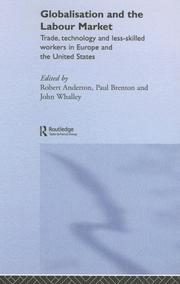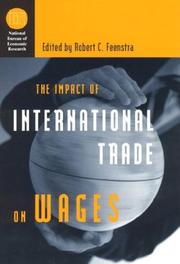| Listing 1 - 2 of 2 |
Sort by
|

ISBN: 0415320127 9780415320122 9780203488850 9781134361960 9781134362004 9781134362011 9780415648011 Year: 2006 Volume: 56 Publisher: London Routledge
Abstract | Keywords | Export | Availability | Bookmark
 Loading...
Loading...Choose an application
- Reference Manager
- EndNote
- RefWorks (Direct export to RefWorks)
Commerce extérieur et emploi --- Commerce extérieur et emploi --- Labour market --- International economic relations --- United States --- Europe --- Foreign trade and employment --- Globalization --- Labor market --- Economic aspects --- Labor market. --- Economic aspects. --- Mondialisation --- Marché du travail --- Aspect économique --- 332.691 --- 382.11 --- EEC / European Union - EU -Europese Unie - Union Européenne - UE --- US / United States of America - USA - Verenigde Staten - Etats Unis --- Employees --- Market, Labor --- Supply and demand for labor --- Employment and foreign trade --- Evolutie van de arbeidsmarkt --- Theorie van het internationale evenwicht. Economische onafhankelijkheid van een natie. Globalisering. Mondialisering --- Supply and demand --- Effect of international trade on --- Markets --- Commerce --- International trade --- Labor supply --- Investments, Foreign, and employment --- Trade adjustment assistance --- Foreign trade and employment - Europe --- Foreign trade and employment - United States --- Globalization - Economic aspects --- COMMERCE EXTERIEUR ET EMPLOI --- GLOBALISATION --- MARCHE DU TRAVAIL --- EUROPE --- ETATS-UNIS --- ASPECTS ECONOMIQUES --- United States of America --- Commerce international et emploi

ISBN: 0226239632 9786611430887 1281430889 0226239640 9780226239644 9780226239637 9780226239637 Publisher: Chicago University of Chicago Press
Abstract | Keywords | Export | Availability | Bookmark
 Loading...
Loading...Choose an application
- Reference Manager
- EndNote
- RefWorks (Direct export to RefWorks)
Since the early 1980's, the U.S. economy has experienced a growing wage differential: high-skilled workers have claimed an increasing share of available income, while low-skilled workers have seen an absolute decline in real wages. How and why this disparity has arisen is a matter of ongoing debate among policymakers and economists. Two competing theories have emerged to explain this phenomenon, one focusing on international trade and labor market globalization as the driving force behind the devaluation of low-skill jobs, and the other focusing on the role of technological change as a catalyst for the escalation of high-skill wages. This collection brings together innovative new ideas and data sources in order to provide more satisfying alternatives to the trade versus technology debate and to assess directly the specific impact of international trade on U.S. wages. This timely volume offers a thorough appraisal of the wage distribution predicament, examining the continued effects of technology and globalization on the labor market.
US / United States of America - USA - Verenigde Staten - Etats Unis --- 382.51 --- 332.27 --- 338.043 --- 332.70 --- Aard, belang en evolutie. Handelsbalans. J curve. --- Loonpolitiek. --- Technologische vooruitgang. Automatisering. Computers. Werkgelegenheid en informatica. --- Geschoolde en ongeschoolde arbeid: algemeen. --- Foreign trade and employment --- International trade --- Wages --- Compensation --- Departmental salaries --- Earnings --- Pay --- Remuneration --- Salaries --- Wage-fund --- Wage rates --- Working class --- Income --- Labor costs --- Compensation management --- Cost and standard of living --- Prices --- Employment and foreign trade --- Labor market --- Commerce --- Labor supply --- Investments, Foreign, and employment --- Trade adjustment assistance --- Effect of international trade on --- Trade theory --- E-books --- Loonpolitiek --- Geschoolde en ongeschoolde arbeid: algemeen --- Technologische vooruitgang. Automatisering. Computers. Werkgelegenheid en informatica --- Aard, belang en evolutie. Handelsbalans. J curve --- Foreign trade and employment - United States --- Wages - United States --- trade, wages, economics, finance, business, international, investment, wage differential, skills, labor, employment, income, globalization, technology, engineering, foreign, education, inequality, offshore assembly, production, manufacturing, competition, exchange rates, nonfiction, product price, job loss, factories, premiums, incentives.
| Listing 1 - 2 of 2 |
Sort by
|

 Search
Search Feedback
Feedback About UniCat
About UniCat  Help
Help News
News